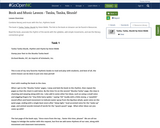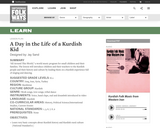
Students will be able to effectively recognize and imitate AB binary form through movement.
- Subject:
- Arts Education
- Music
- Material Type:
- Lesson Plan
- Provider:
- Teachers.Net
- Author:
- Meghan Webb
- Date Added:
- 02/26/2019

Students will be able to effectively recognize and imitate AB binary form through movement.

Students will discover the differences in musical tempo between fast and slow. Students will learn to use the
correct musical terms to describe the tempo of each piece. Students will use streamers and their bodies to
show at what tempo each piece is played.

Students will discover how to read music notes in the treble clef and then will learn to perform simple songs on
xylophones, through reading the story Freddy the Frog and the Thump in the Night by Sharon Burch.

Students will learn ABA form through movement. This lesson is designed to fulfill Standard #6 of the National Standards for Music: Listening to, analyzing, and describing music.

By listening to the words of Beethoven, students will become familiar with Beethoven's feelings about being out in nature and his desire to express these feelings through his Symphony No. 6, rather than create images of pastoral life. Students will explore and identify images of the countryside and feelings about the countryside, and note the difference. Students will identify and explore the range of possible feelings one may have when in the countryside. Students will respond to Beethoven's music and feelings about the countryside through creative movement.

Students will learn about dynamics, tempo, acoustics and instruments in the music of Charles Ives. Students will be introduced to and learn about the literary term onomatopoeia, and how they can relate it to the sounds of Ives' music. Making the connection between literacy and music, students will create their own musical onomatopoeias using various media, such as water color, tempera paint, crayons, magazine text and markers.

Combine literacy and music with this fun, rhythmic book!The book is Tanka, Tanka, Skunk! by Steve Webb. The link to the book on Amazon can be found in Resources. Read the book, associate the rhythm of the words with the syllables, add simple movements, and see the literacy connections grow!

How does someone who is deaf enjoy music? Can they hear it? Can they make it? Through exploring the life and music of Evelyn Glennie, students will understand that music is sound produced by vibrations. This understanding will allow them to create their own instrument out of objects and compose a musical score for presentation.

This lesson introduces basic communication skills by asking the following questions: "What does communication mean? What do good communicators do? Selections from Fanfare for the Common Man Fanfare for the Common Man by Aaron Copland and Carnival of the Animals by Camille Saint-Saëns will help us define musical terms and discover the answers to our questions.

Students will be able to relate the similarities and differences experienced by orchestra members and students of a first grade class as connected to the idea of the interdependence within a community. They will recognize that as members of a classroom community there are expectations for jobs, behavior, and intrinsic motivation to function to the best of the individual's ability. They will understand that a community within an orchestra has a similar construct to a classroom in that it is led by a conductor and that each person plays an important role within the playing of a piece, practicing their individual part, and colleague support.

Copland, an American maverick, becomes a storyteller as he writes about life in the early years of America. His Appalachian Spring helps students understand how people, places and things change over time, while his musical sketch reinforces the six traits of writing.

DSOKids is the Dallas Symphony Orchestra’s magical doorway to a world of musical fun and learning for students, parents and teachers. The site’s mission is to provide attractive, accessible and child-friendly resources that introduce symphonic music, the orchestra and its instruments, and to encourage both adults and young people to explore the world of the symphony orchestra.

Students and their teachers are introduced to the Kurdish people and their history and culture by
leading them on a Kurdish experience full of singing and dancing.

Students will be introduced to the great jazz composer and band leader, Duke Ellington by listening to his re-composed and re-orchestrated version of Nutcracker Suite by Pyotr Tchaikovsky. Students will be passively introduced to the music of Duke Ellington with the goal that students recognize similar melodies in his work to those of Tchaikovsky. Students will learn about jazz instruments and connections will be made to literature, social studies, music and writing.

Students will larn about a time in the past when three famous people- Igor Stravinsky, George Balanchine and John Ringling, Jr. - joined forces to create a ballet for ballerinas the size of battleships. Students will listen and move to Stravinsky's Circus Polka: For a Young Elephant, written for the ballet that featured fifty ballet dancers and fifty elephants. Students will hear the story, Ballet of the Elephants, and learn about the men who worked together to make it happen.

Students will learn to focus and listen to music and begin to recognize the musical elements of dynamics and tempo. Students will learn to discuss the emotions that music can portray and evoke with a writing activity to allow students to brainstorm ideas of what they hear.

Students learn eight basic locomotor skills of walking, running, jumping, hopping, skipping, galloping, side sliding and leaping. The teacher teaches the difference between fast, medium, and slow movements while introducing the musical vocabulary for tempo: fast/presto, medium/moderato and slow/adagio. The students listen to the beat of a percussion instrument and determine if they should move fast, medium, or slow to match the tempo of the beat.

In this lesson plan, students will become familiar with the music of Rimsky-Korsakov in fullfillment of the National Standards for Music (listening to, analyzing, and describing music).

While studying ecosystems, students will focus on the changes that occur in deciduous forest throughout the seasons. With that knowledge, they will listen to and analyze Vivaldi's The Four Seasons. As a culminating activity, students will use oil pastels to show what a deciduous forest would look like during each season.

Featured here are three traditional songs from England that call for opportunities to sing,
move, and listen attentively. Each song offers young children the opportunity to be
creative in their physical expressions while also following direction in a sequential order.
These experiences allow the teacher a straightforward means for taking folk and
traditional songs of England into classrooms of young children.